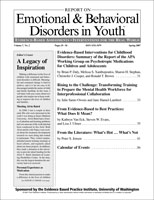The Interconnected Systems Framework and Dissemination Efforts in the Carolinas
Author: Kelly Monahan.; Melissa W. George.; Joni W. Splett.; David Riddle.; Lauryn Morrison; Mark D. Weist.
Source: Volume 14, Number 04, Fall 2014 , pp.78-86(9)

next article > |return to table of contents
Abstract:
Despite widespread efforts to improve school-based behavioral and mental health services for children and youth, current initiatives are often uncoordinated and isolated. The purpose of this article is to introduce an effort, called the Interconnected Systems Framework (ISF), to blend two initiatives—School Mental Health (SMH) and Positive Behavioral Interventions and Supports (PBIS)—and to highlight the resources essential for promoting their interconnected implementation. The ISF builds capacity in schools to meet youths’ behavioral and mental health needs by leveraging the strong implementation principles of PBIS and the depth of intervention services of SMH to address the lack of an implementation structure of SMH and the lack of well-implemented services for PBIS intervention and treatment. The article reviews the strengths and limitations of SMH and PBIS and describes the core features and implementation principles of the ISF. It also highlights efforts to support dissemination and adoption of ISF nationally and regionally through systems-level resources in North and South Carolina and in two communities of practice, and it discusses barriers to, and recommendations for, implementation. All of the authors are affiliated with the University of South Carolina’s Department of Psychology School Mental Health Team, where Kelly Monahan is data coordinator, Melissa George, Ph.D., and Joni Splett, Ph.D., are research associates, David Riddle is a research assistant, Lauryn Morrison is a graduate assistant, and Mark Weist, Ph.D., is director.Keywords: Positive Behavioral Intervention and Supports, Interconnected Systems Framework
Affiliations:
1: University of South Carolina; 2: University of South Carolina; 3: University of South Carolina; 4: University of South Carolina; 5: University of South Carolina.